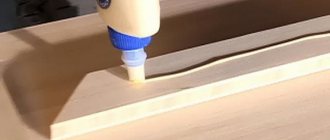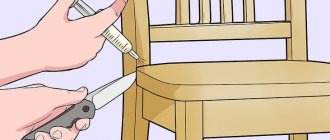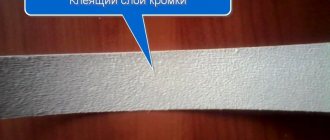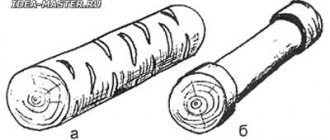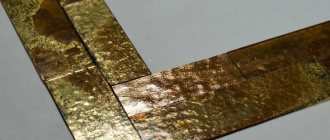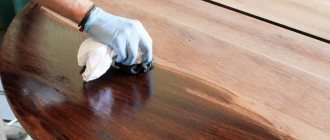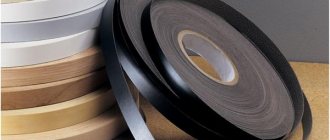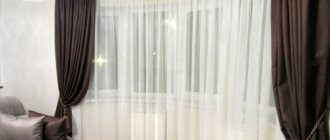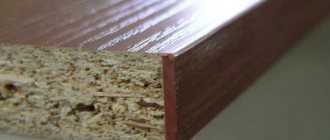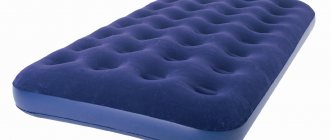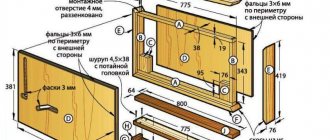Currently, some interior products are made from artificial materials.
But many people prefer wooden furniture.
Therefore, in some cases in everyday life there is a need to restore or repair wooden products (for example, chairs).
And it is not always possible to use traditional fasteners using nails, screws and other elements for connection.
Very often, during use, such chairs become loose and break.
Before you start working, you need to inspect the chair. If all the crossbars begin to come out of the grooves or wobble in the grooves, then it is better to disassemble the chair completely.
Often the best option is to glue the necessary fragments together.
The skillful hands of a home craftsman may well save him.
For this reason, you need to know which glue is suitable for repairing wooden structures.
Any type of glue should be chosen based on the specifics of its use.
Therefore, before purchasing, you need to get an idea of what properties it should have, that is:
- Drying time;
- Bonding density;
- Moisture resistance;
By following the instructions and taking into account all the gluing requirements, everyone has the opportunity to achieve the desired effect with their own hands. - Versatility of use;
- Strength of connection;
- Degree of toxicity.
It is necessary to first familiarize yourself with the characteristics of a particular product in order to make the right choice.
How to choose the right glue
So, how to glue a wooden chair if it is broken?
First you need to decide what kind of glue you will use to secure the chair. To understand what kind of glue to glue wooden chairs with, you must first familiarize yourself with the list of qualities that it must have. This includes:
- Resistant to water and light.
- Strong adhesion to porous wooden surfaces.
- The ability to form a strong, tight seam that can withstand external influences.
- Colorless transparent texture after drying.
- Convenient to use.
- Resistant to sudden temperature changes and aggressive environments.
- Prevents the formation of fungal colonies on the surface.
- Long duration.
- No streaks on the glued parts of the chair.
- Fast drying.
- Acceptable price.
- Ecological composition.
- No toxic components in the glue.
Wood glue must meet certain requirements.
Types of glue that have all of the above properties and are therefore suitable for gluing elements of wooden chairs:
- Vinyl glue.
- BF glue (phenolic butyral).
- Epoxy adhesive.
- Polyurethane glue.
- Syndeticone glue.
Which furniture glue is best? The most effective on this list is PVA glue, which mainly contains a dispersion of polyvinyl acetate. Due to the percentage of this main component in the adhesive and other add-ons, its functionality varies.
For wooden chairs, it is recommended to use PVA wood glue; plasticized dispersions D40P-D53P are also suitable for gluing.
Kinds
The greatest demand now is for PVA, polyurethane compounds and resin-based mixtures. They differ significantly from each other.
Features of popular adhesives for wood furniture:
- PVA – this name hides a polyvinyl acetate dispersion. This substance is non-toxic, so it can be used indoors for repairing wooden products. It is waterproof, affordable, and very easy to work with.
- Resin mixtures are especially popular among woodworkers and homeowners. Epoxy compounds provide reliable adhesion to surfaces made of wood and other materials. The substances are not afraid of moisture and aggressive chemical elements.
- Polyurethane adhesive can withstand fairly high loads; it is especially suitable for use on wooden furniture legs. The glue can be used in extreme conditions.
When choosing a product for wood, you need to consider the following points:
- Connection density.
- Toxicity level.
- The period of complete hardening.
- Moisture resistant.
- Seam strength.
PVA
PVA glue is considered to be a stationery glue, but it is also successfully used when working with wood. This is a safe and high-quality product that not only reliably connects surfaces, but is also able to withstand high humidity and liquids for a long period.
Woodworker PVA is considered the best adhesive for wood. With its help, you can glue different types of wood together and with building materials such as chipboard, plywood, MDF.
For reliable setting after joining, the parts must be pressed tightly against each other for half an hour. Complete hardening of the composition, when the parts can already be used, occurs within 24 hours. This wood adhesive composition does not change the color of the wood and does not disturb its structure. Operation is possible under conditions from 5 to 30 degrees.
Reference! Woodworkers and home craftsmen note that this composition is excellent for wood due to its quick setting, strength and accessibility.
KLEIBERIT is a waterproof PVA composition with universal characteristics. They can be used to connect wood with other surfaces. What sets it apart is its ability to glue exotic woods.
After drying, this glue turns white. It can withstand temperatures from -30 degrees. It is chosen for its setting speed, frost resistance and resistance to liquids. The downside is the importance of strictly following the instructions.
Wood glue
Wood glue is based on aliphatic resins. The material is used for joining wooden products - home and outdoor furniture. One of the best would be bone glue, which is great for antiques.
After applying this glue, you need to dry it under pressure for some time. Alcohol can be used to disassemble the connection.
Syndeticone
Syndeticone glue is prepared from carpentry by adding lime and powdered sugar. The material has an increased level of structural adhesion. It is waterproof and resistant to chemicals.
Reference! The disadvantage of such a product for wood will be the long manufacturing process. To obtain good glue, you will need to soak it in liquid for 24 hours.
Glue BF
Thermosetting or BF adhesive composition connects elements when exposed to high temperatures.
It can be single- or multi-component. The first option can be purchased ready-to-use. Multicomponent glue must first be prepared by mixing several substances.
BF can be inorganic, organic and organoelement. Available in liquid, dry and solid form. Water-based products take longer to harden, which must be taken into account when choosing, but substances with solvents set almost instantly.
Epoxy resin
Epoxy resin glue is good for gluing wood together. It's also great for filling gaps. It is waterproof and has optimal strength characteristics.
The glue is two-component, that is, it consists of a resin and a hardener. To prepare, they need to be mixed in a certain proportion, as indicated in the instructions. The positive side is that this furniture glue does not shrink.
Reference! Different ratios of elements give the glue different properties, which can be controlled under certain conditions. What’s also good is that gluing does not require long pressing.
Urea resin
Urea resin adhesive is prepared from thiourea or synthetic urea through a heating process. Such compositions create very strong compounds of wood products. They are resistant to moisture and can be used in extreme conditions.
This glue is acid-curing, and after mixing with a hardener its service life is short - up to 4 hours. It is used for hot pressing.
Reference! This glue is transparent, which is very beneficial when gluing wooden furniture.
Polyurethane glue
When high strength, resistance to liquids and mechanical loads are important, you can safely opt for polyurethane adhesive.
A well-known representative is Soudal 66 A, produced in Belgium. It can be used in harsh environments to bond wood products even if they are wet. It is compatible with most building materials.
Reference! When hardened, the composition foams, which allows it to fill all seams and cracks.
Polyurethane wood adhesive mixture can be used for complex carpentry work indoors and outdoors. They love it for its excellent strength, water resistance, and reliable grip.
Kleiberit 501.0 is another polyurethane composition, but from a German manufacturer. This is a good universal furniture adhesive that is not afraid of high temperatures and moisture. Can be used when combining different materials.
The adhesive receives good reviews due to its convenient use, flawless connection and optimal consistency. When working with it, it is important to ventilate the room and protect the skin.
Liquid Nails
Liquid nails are a good option for furniture. They consist of polymers and rubber. The material is distinguished by its plasticity and strong connection. This is an alternative to conventional nails when work needs to be done quietly and cleanly. The composition may also contain solvents.
Advantages of using liquid nails for furniture:
- High strength - this glue can withstand up to 80 kg per cm;
- The mixture does not disturb the surface structure.
- Can be used to connect uneven substrates.
- Not subject to corrosion.
How to glue a wooden chair
Not all adhesives are used to hold wood elements together.
For furniture repair, substances are selected that meet the following requirements:
- water resistance;
- high adhesive properties - the factor contributes to the formation of a reliable seam;
- transparency - when dry, such glue will not leave streaks on the surface of the chair;
- high drying speed;
- environmental composition - the presence of toxic substances in the glue makes it undesirable
- household use.
Many types of glue have these qualities; the most suitable for processing wooden furniture are:
Each of these options has its own characteristics and advantages. PVA glue has an unlimited shelf life and low price. In addition, it is completely non-toxic.
The advantage of the BF composition is quick drying and use for products located in conditions of high humidity. This could be a kitchen or bathroom cabinet.
Tools needed for repair
To restore a dried out wooden chair at home, you should ensure that you have working tools and related materials.
To carry out the work you will need:
- hammer;
- sandpaper (for surface treatment);
- clamp;
- knife;
- chisel.
Also, a piece of tissue will be useful in the process of work (the structure of tissues of living organisms is studied by the science of histology)
, which removes excess glue from the surface of the chair.
What glue should I use for repair work?
If your wooden chair is broken, it is recommended to use the best wood glue for repair. Today the greatest demand is:
- "Kleyberite."
- Plotnitsky “moment.
- Trebond."
Professional carpenters have the following requirements for glue:
- It must be resistant to sunlight.
- Universal to use.
- The adhesive connection must be strong.
- It is recommended to use moisture-resistant glue.
- There should be no sticky marks on the surface.
- It shouldn't be toxic.
If you ask a professional how to glue a wooden chair, they will probably recommend using epoxy glue. It is more suitable for wooden products. PVA glue can be used. Some use a two-component composition.
Repairing a wooden chair: how to glue wood tightly
Loose knots are untied first. Sometimes it is necessary to completely disassemble the chair to complete the job. This must be done carefully so as not to damage the grooves.
If you only need to glue one leg, complete disassembly is not required.
Next, remove any remaining old glue from the surface of the lugs or dowels. This procedure is performed with a knife or chisel. If the old composition does not go away, the parts can be sprayed with hot steam. Also, the desired effect is achieved using vinegar or solvent.
Then, using sandpaper, the wooden surfaces are cleaned of dried glue. The resulting chips and dust are wiped with a damp cloth.
It is important to consider that the key to reliable bonding is high-quality cleaning of surfaces.
At the next stage, glue is applied and the elements of the chair are inserted into the corresponding grooves and hammered in until they stop. If the element cannot be completely pulled out, glue is injected into the groove using a syringe.
First, you need to stretch the frame as much as possible. Remove excess glue with a flap. For reliability, wooden furniture is fixed with a clamp, pressure or tension belts.
Repaired furniture must be dry, which must be checked before removing the screed. The time required for the glue to harden is indicated on the packaging. For PVA this interval is 24 hours.
You can glue a wooden chair with cracks at home.
You don't need to have any special skills to do this. The key to success is a high-quality adhesive composition. If, after carrying out repairs yourself, wooden furniture does not stop creaking, then you need to seek help from a specialized workshop.
We invite you to watch an interesting video about chair repair:
Directly re-gluing chairs
After you have cleaned the tenon joints, you can begin gluing directly.
Important! PVA glue takes quite a long time to dry, but fortunately the time required for it to harden is indicated on the label.
Proceed as follows to glue a wooden chair:
- Securely fasten all your glued parts so that they are pressed directly against each other with the necessary pressure.
- To securely fasten the glued parts, a clamp or special tension belts are used.
- To ensure that the varnished surface of the wood is not damaged after this and that no marks remain on it, be sure to use spacers.
Important! You can use wooden blocks or thick rubber as spacers, but fabric will not work.
- You will need a small number of clamps to secure all the parts. Using straps, you can secure several sides at the same time, which is incredibly convenient.
Important! Check the tension of all belts until the adhesive solution has completely cured. If they become loose, tighten them immediately.
How to glue a chair correctly
Before you start gluing the chairs, clean all joints of old glue. To make scraping easier, apply warm vinegar or a small amount of solvent and then remove any residue from the surface.
On some upholstered chairs, the seat panels are not firmly attached to the frame and, as a result, lose the necessary stability. This defect can be eliminated if triangular or trapezoidal solid wood wedges are firmly screwed to the side frames forming the inner corners of the frame. This will strengthen the frame, it will remain stable even if the chair, for example, tips over or starts to move.
If the chair is used frequently and under heavy loads, the brackets may also become loose. In this case, replace the old screws with new ones - they should be slightly thicker than the old ones.
Drill holes in the corner wedges and herons so that the screw heads will fit into them.
For corner wedges, choose self-tapping screws of such length that they provide sufficient strength to the joints without going through the drawers.
It is best to cut a new wedge from well-seasoned hardwood.
A thorough inspection of the old wood blocks will help you determine whether they need to be replaced or whether it is sufficient to scrape off the old glue and apply new glue, then drive in new screws. Be sure to replace the split and split wedges with new ones, which need to be cut from solid wood exactly to the shape of the old ones, then glue them to the side frame and screw them in with self-tapping screws.
Adhesive joints should be secured with clamps, staples or ropes until the adhesive is completely dry.
The glue must dry under pressure. Therefore, it is recommended to clamp the newly glued frame with clamps, staples or ropes and hold for about 12 hours. In this case, you should not apply too much pressure, otherwise a lot of glue will come out of the grooves. After a while, release the tension a little.
Make sure the chair frame is at the correct angle and does not tilt while pulling. This requirement is easy to fulfill when repairing ordinary chairs. It is more difficult, for example, with English chairs or rocking chairs. However, at least the front of the chair can be checked using a plumb line.
Additional gluing points
Experts advise to carefully clean the connecting areas that will be glued together later. If the old glue is difficult to scrape off, apply warm vinegar or solvent to the cleaning area.
To secure the system firmly, almost all craftsmen, after gluing the parts, use a tension belt or clamp for tight pressing and quick drying.
If, after repairing the structure, creaks and other obstacles remain, and the seals did not help, it is better to use the services of experts and contact a workshop for help.
Possible mistakes
Often, after gluing, furniture continues to sway and squeak. If the chair falls apart, the procedure was carried out in violation of technology. Let's look at the main culprits of the problem.
The composition has not dried
The drying time of most modern adhesives is up to 24 hours. Even if the manufacturer promises availability on the label in 30 minutes, this is a setup period. The composition gains strength within 24 hours after application.
External factors may prevent the adhesive from curing. Products dry slowly at low temperatures and high humidity. If you need to quickly make repairs, in the cold season it is better to move the furniture to a warm room after gluing.
Violation of technology
To ensure that the glue adheres well, the surface is prepared before application. Old residues are removed from the wooden chair parts and then degreased with alcohol. Professionals recommend making small cuts with a knife in the transverse plane of the spine. The method will make it easier to join the parts.
The glue may dry before the connectors touch. Wood absorbs excess moisture, especially indoors in hot summers or heat. If the performer maintains the composition, the product does not have time to act on the surface.
The glue won't stick if it's loose. In order for a wooden chair to stick, the structure must be secured. Carpenter's clamps (collars) or rubber bands will help hold the parts in place. The structure is dismantled one day after treatment.
Glue should not get into the seams. To glue a wooden chair, it is necessary to dismantle the problematic part and adjacent elements. The mass should penetrate accurately and generously into the furrow and tip. Without dismantling, even the most durable composition will not cope with the task.
The product was chosen incorrectly
If the mass does not stick, it means that the wrong glue was used for the wooden chair. Universal compounds also have a list of surfaces with which they work. A leather, glass or plastic cleaner will not necessarily restore wood. You should not experiment with building materials - it is prohibited to use polyurethane foam or grout for furniture tiles.
Advice from the experts
Before starting work, you need to prepare the necessary tools, clean the surfaces that will be glued and carefully study the instructions.
Reference! After gluing, it is important to press the elements for a while to ensure reliable adhesion. This must be done for at least 10 minutes.
When you need to glue it together forever, synthetic glues are better suited, but if you need to further disassemble the furniture, you should use a natural one, like casein or bone glue.
For light types of wood, it is better to use Joiner glue, which adapts to the shade of the material. Casein glue is contraindicated in this case.
When choosing PVA glue, you need to pay attention to the consistency. If it is too liquid, you should not take it, because this indicates hypothermia, which has a bad effect on the adhesive ability.
When choosing glue, it is better to give preference not to universal, but to special compounds that are intended for certain materials and conditions.
Source (full version): https://gidpokraske.ru/vidy-kleya/mebelnij-klej.html
How to make wood glue with your own hands
Often a carpenter is needed on a farm. Cooking it yourself is not difficult. To prepare, you only need a tile of wood glue.
Before firing, the tile is broken, its fragments are placed in a prepared container and filled with cold water. Next, you need to wait until the tiles are saturated. This may take 10-11 hours.
After the formation of a jelly-like mass, the container is placed in a water bath, the contents must be constantly stirred. If thick glue is not needed, you need to add a little hot water to the container.
The mixture should not be brought to a boil. The contents are infused, stirring constantly until all lumps are completely dissolved. The absence of lumps indicates that the glue is ready for use.
When preparing the mixture, you can use different additives. They will improve the characteristics of the mixture and expand its scope of application. For example, adding linseed oil or drying oil to the composition can increase the water resistance of the glue.
Painting stool legs
If you need to paint the legs of a stool, as in my case, then it is best to do this work without unscrewing the legs from the fastenings. In this case, there will be no need to hold the legs while painting and hang them to dry. To protect the seat of the stool from paint, you can cover it with newspaper, having previously cut holes in it for the legs. If the newspaper is torn in places, these areas can be closed by sealing them with masking tape or a piece of newspaper using glue.
It is best to paint the legs using a roller with waterproof paint. Then the surface of the legs is smooth and without smudges. If you don't have a roller, you can use a brush. When the paint is completely dry, the stool is ready for use.
After restoration with my own hands, the stool changed beyond recognition and became a decoration of the kitchen room.
What foods fix stool for diarrhea, list
The diet helps fight diarrhea by including in your diet foods that contain pectin, fiber, and astringents. These include:
1 porridge cooked without oil in water (rice, buckwheat);
2 lean boiled meat;
3 boiled eggs (“hard-boiled”);
4 baked apples;
5 bananas, persimmons, pomegranates;
6 crackers, nuts.
Drinks include decoctions of medicinal herbs containing tannins, teas and berry jelly:
1 decoction of blueberries;
2 pomegranate infusion (prepared from pomegranate peels, steamed with boiling water);
3 dried fruit compote (especially pears);
4 currant jelly;
5 decoctions of oak bark, St. John's wort, elecampane;
6 strong tea without sugar.
Remember: there are many remedies for diarrhea, but it is better to entrust the choice to a doctor, who will not only help determine the cause of diarrhea, determine a list of medications, but also take into account the individual characteristics of your body.
